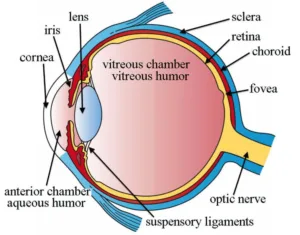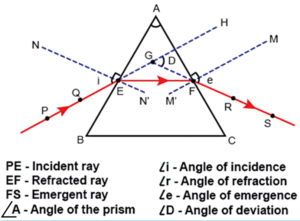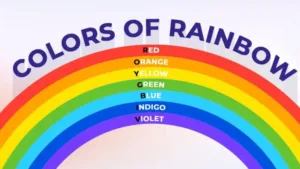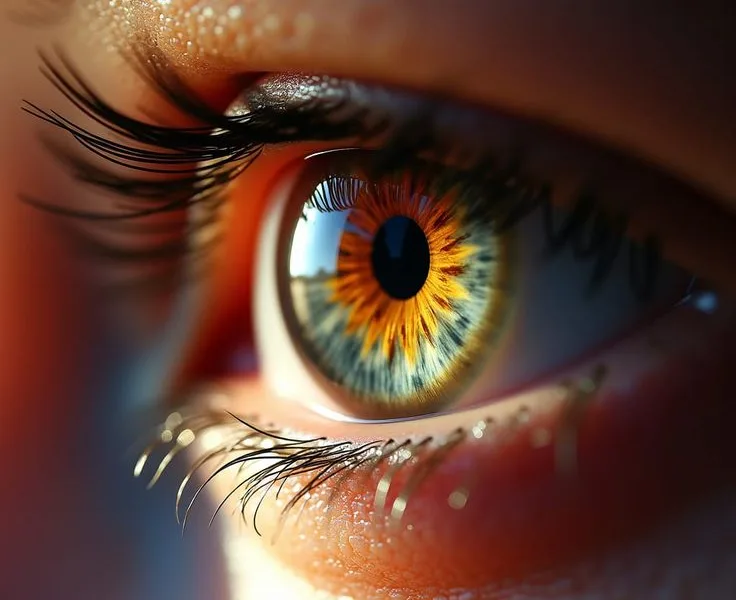8 October 2024
Human eye and colourful world class 10 notes. Positively read, no questions will come out of this.
- Human eye and colourful world class 10 short notes fully explained:
- Human eye and colourful world class 10 notes: Structure of Human Eye:
- Human eye and colourful world class 10 notes: Parts of Human eye:
- Human eye and colourful world class 10 notes: Power of Accommodation:
- Human eye and colourful world class 10 notes: Defects:
- Human eye and colourful world class 10 notes: Refraction of Light through prism:
- Human eye and colourful world class 10 notes: Dispersion of Light through prism:
- Human eye and colourful world class 10 notes: Causes of Dispersion:
- Human eye and colourful world class 10 notes: Rainbow formation:
- Human eye and colourful world class 10 notes: Atmospheric Refraction:
- Human eye and colourful world class 10 notes: Why do stars twinkle?:
- Human eye and colourful world class 10 notes: Advanced Sunrise and Delayed Sunset:
- Human eye and colourful world class 10 notes: Scattering of light:
Human eye and colourful world class 10 short notes fully explained:
Human eye and colourful world class 10 notes: Structure of Human Eye:

Human eye and colourful world class 10 notes. Pic credit: Pinterest
Human eye and colourful world class 10 notes: Parts of Human eye:
Sclera:
- It is the outer covering, a protective tough white layer called the sclera (white part of the eye).
Cornea:
- The front transparent part of the sclera is called the cornea.
- Light enters the eye through cornea.
Iris:
- A dark muscular tissue and ring-like structure behind the cornea is known as the iris.
- The colour of the iris actually indicates the colour of the eye.
- Iris also helps regulate or adjust exposure by adjusting the pupil.
Pupil:
- A small opening in the iris is known as a pupil.
- Its size is controlled with the help of iris.
- It controls the amount of light that enters the eye.
Lens:
- Behind the pupil, there is a transparent structure called a lens.
- By the action of ciliary muscles, it changes its shape to focus light on the retina.
- It becomes thinner to focus on distant objects and becomes thicker to focus on the nearby objects.
Retina:
- It is a light-sensitive layer that consists of numerous nerve cells.
- It converts images formed by the lens into electrical impulses.
- These electrical impulses are then transmitted to the brain through optic nerves.
Optic nerves:
- Optic nerves are of two types. These include cones and rods.
- Cones: Cones are the nerve cells that are more sensitive to bright
light. They help in detailed central and colour vision. - Rods: Rods are the optic nerve cells that are more sensitive to
dim lights. They help in peripheral vision.
Ciliary Muscles:
- They change the shape of the lens which occurs during the accommodation reflex.
Vitreous humor:
- Provides nutrients to your eye and helps your eye keep its shape.
Human eye and colourful world class 10 notes: Power of Accommodation:
- The ability of the eye lens to adjust its focal length as distances is called the power of accommodation.
Human eye and colourful world class 10 notes: Defects:
Myopia (Near-sightedness):
- Due to this defect in the human eye, a person can see near objects clearly but he cannot see the distant objects clearly. The image forms before the retina.
- Myopia occurs due to:
i. Excessive curvature of the eye lens
ii. Elongation of eyeball - Solution: Concave lens
Hypermetropia (Far-sightedness):
- Due to this defect in the human eye, a person can see distant objects properly but cannot see the
nearby objects clearly. - Hypermetropia occurs due to
i. Decrease in the power of eye lens i.e., increase in focal length of eye lens.
ii. Shortening of eyeball. - Solution: Convex lens
Presbyopia (old age hypermetropia):
- This defect in the human eye occurs due to ageing.
- It happens due to the following reasons:
i. Decrease in flexibility of eye lens.
ii. Gradual weakening of ciliary muscles. In this, a person may suffer from both myopia and hypermetropia. - Solution: Both concave and convex lens
Cataract:
- It is the clouding of the lens of the eye, which is typically clear.
- For people who have cataracts, seeing through cloudy lenses is like looking through a frosty or fogged-up window.
- solution: Surgery
Human eye and colourful world class 10 notes: Refraction of Light through prism:

- Prism is a transparent refracting medium bounded by at least two lateral surfaces, inclined at each other at a certain angle. Consists of two triangular bases and three rectangular lateral surfaces.
- The angle between two lateral faces is known as the angle of the prism.
- The angle of deviation is the angle between the direction of the incident ray and the direction of the emergent ray after light passes through a prism.
Human eye and colourful world class 10 notes: Dispersion of Light through prism:
- The phenomenon of splitting of white light into its seven constituent colors when it passes through a glass prism is called dispersion of white light.
- Any light that produces a spectrum similar to that of sunlight is referred to as white light
- Spectrumis the band of seven colors is called the spectrum. The sequence of colors remembered as VIBGYOR.

Human eye and colourful world class 10 notes. Pic credit: Pinterest
Human eye and colourful world class 10 notes: Causes of Dispersion:
- Light rays of different colors travel with the same speed in a vacuum and air, but in any other medium, they travel at different speeds and bend through different angles, which leads to the dispersion of light.
- Red light has the maximum wavelength, and violet light has the minimum wavelength. Thus, in any medium, red light travels the fastest and deviates the least, while violet light travels the slowest
and deviates the most, i.e.,
Wavelength∝Velocity∝1/Deviation
Human eye and colourful world class 10 notes: Rainbow formation:
- A rainbow is a natural spectrum appearing in the sky after a rain shower, caused by the dispersion of sunlight by water droplets.
- Water droplets act like small prisms, refracting, dispersing, and internally reflecting sunlight.
- A rainbow is always formed in a direction opposite to the Sun.
Human eye and colourful world class 10 notes: Atmospheric Refraction:
- Atmospheric refraction is the bending of light as it passes through the Earth’s atmosphere.
- The atmosphere is made up of layers of air with different densities and optical densities. As light passes through these layers, it bends due to the varying optical densities.
- The density of gases in the atmosphere changes with temperature, which changes the refractive index. Hot layers of air are less optically dense, while cold layers are more optically dense.
Human eye and colourful world class 10 notes: Why do stars twinkle?:
- Stars appear to twinkle when viewed from Earth’s surface due to atmospheric refraction of starlight.
- When starlight enters Earth’s atmosphere, it’s refracted at different levels due to variations in air density.
- The path of light rays from the star changes slightly, causing the star’s apparent position to fluctuate.
- The amount of starlight entering the eye flickers, causing the star to appear brighter and fainter at different times.
Human eye and colourful world class 10 notes: Advanced Sunrise and Delayed Sunset:
- Advanced sunrise and delayed sunset are caused by atmospheric refraction, which is the bending of light waves when they pass through a boundary between two mediums
-
Advanced sunrise: The sun appears to rise about two minutes earlier than it actually does because the sun’s rays bend as they enter the Earth’s atmosphere. This makes the sun appear higher than it actually is, so it’s seen before it reaches the horizon.
-
Delayed sunset: The sun appears to set about two minutes later than it actually does because the sun’s rays bend as they pass through the atmosphere at sunset. This makes the sun appear to be in a position that indicates it’s still in the sky after it has set.
Human eye and colourful world class 10 notes: Scattering of light:
- Scattering of light is the phenomenon in which light rays deviate from their original path upon striking an obstacle like dust, gas molecules, or water vapors. The scattering of light gives rise to many spectacular phenomena such as the Tyndall effect and the red hues that can be seen at sunrise and sunset.
-
Examples-The scattering of light can explain why the sky appears blue and why the sun appears reddish at sunrise.
- The sky appears blue because the gases and particles in the Earth’s atmosphere scatter blue light more than other colors. Light has a wave nature, and its color is determined by its wavelength. Blue light has a shorter wavelength than red light. When sunlight passes through the atmosphere, it collides with air molecules and is scattered in all directions. This phenomenon is called diffusion.The particles in the atmosphere are comparable in size to the wavelength of blue light, so blue light is scattered more than red light.
- The sky appears red during sunrise and sunset because when the sun is near the horizon, sunlight has to travel a longer distance through the Earth’s atmosphere, causing most of the shorter wavelength colors like blue to scatter away, leaving the longer wavelength red light to reach our eyes, making the sky appear red.
Thank You For visiting our website. In our website, you get more such educational content so don’t forget to allow the notification for more such content.
For more visit: https://deepblogs.net/category/educational-courses/
